Family : Serranidae

Text © Giuseppe Mazza

English translation by Mario Beltramini
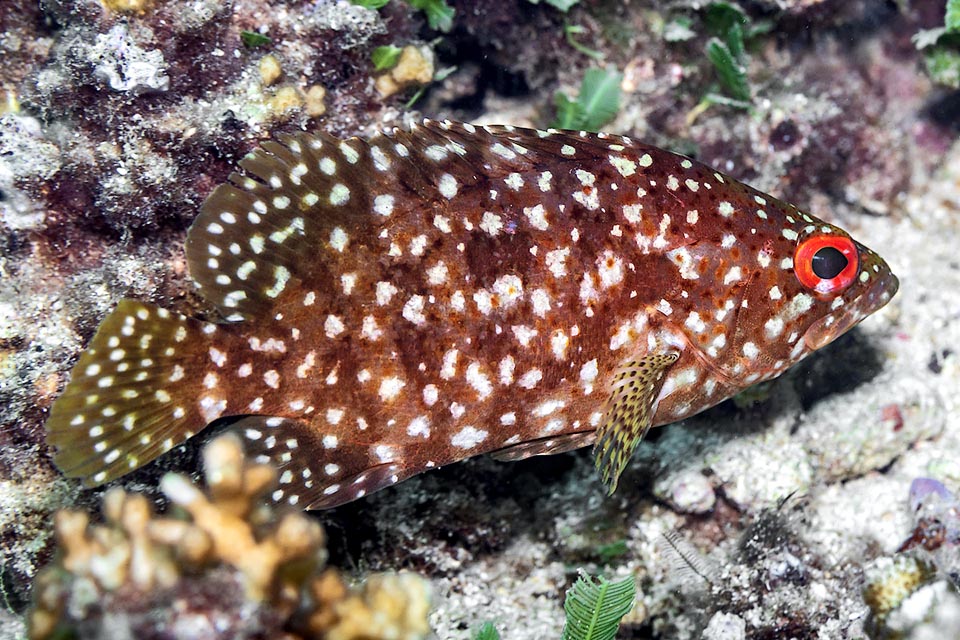
Alphestes immaculatus is a Pacific mini-grouper, present from Mexico to Peru and Galapagos, who defends and preys acting on chromatophores with smart mimetic effects © Allison & Carlos Estape
We are used to considering the groupers as big fishes and globally at risk because they are very much fished, for the changes done by man along the coasts that destroy their dens, or for their quite often very low resilience that requires even 14 years for the theoretical doubling of the populations.
Consequently come immediately to mind Epinephelus marginatus, Epinephelus itajara or the gigantic Epinephelus lanceolatus that reaches 270 cm with a published weight of 400 kg and to whom even 14 years are insufficient for doubling the number.
But in the case of a mini grouper, Alphestes immaculatus Breder, 1936, it’s completely the opposite, as being poorly fished, it is not particularly linked to a den and presents an excellent resilience.
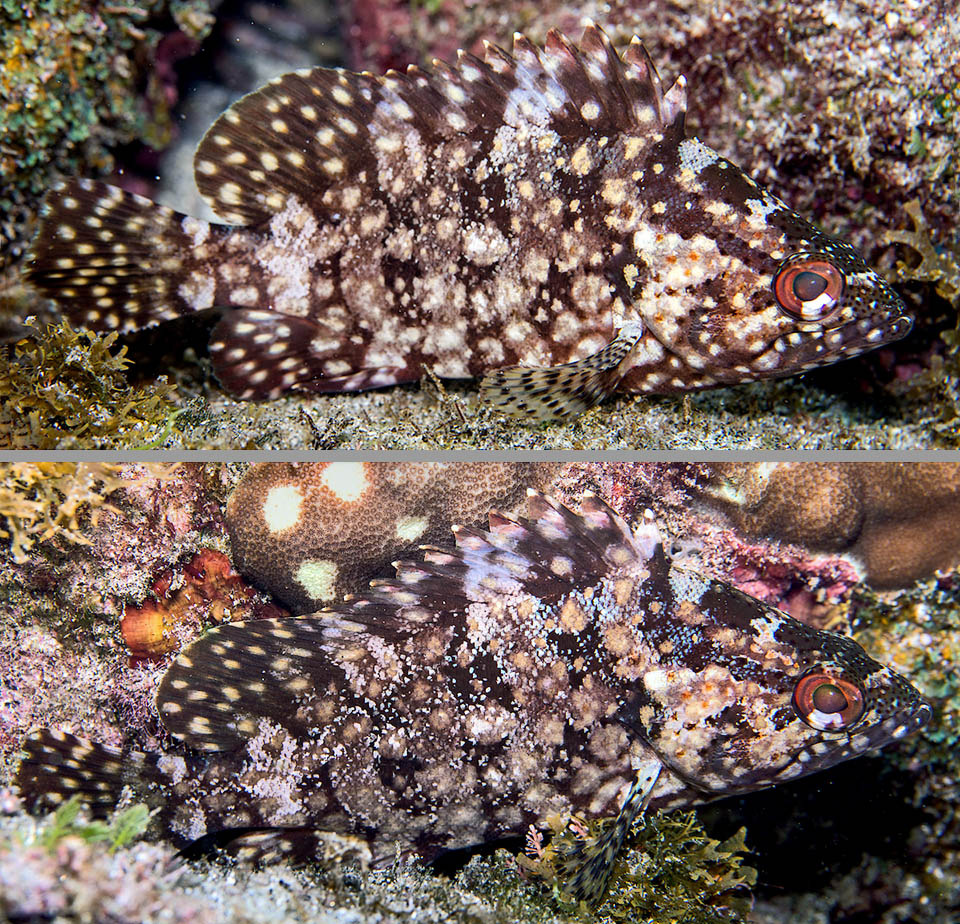
Here is the same fish after having moved. In the lower photo the white has faded and in the dark parts we note the minute blue dotting previously mitigated © Allison & Carlos Estape
In its small way it belongs as the other groupers to the class of Actinopterygii, the ray-finned fishes, to the order of the Perciformes, family Serranidae and subfamily Epinephelinae.
Alphestes, the name assigned in 1801 to the genus by Bloch & Schneider, is the name the old Greeks gave to a “greedy and incontinent fish having a bad reputation”, whilst the specific term immaculatus, spotless in Latin, at first sight might be said wrong.
But, observing carefully the livery, we realize that it is more marbled than spotted, and then the term was born in opposition to the analogous Alphestes multiguttatus who frequents the same waters and is far from being immaculate, marked as it is with dark spots.
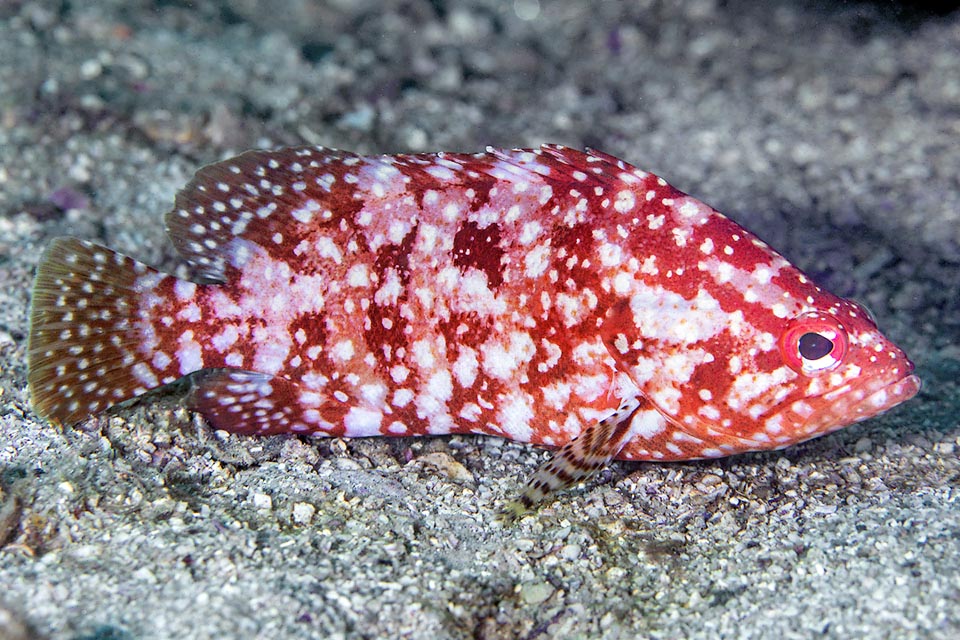
This coloured red. In common with previous photos it has only the uncertain vertical dark bands and more or less pinkish zones in the clear parts © Allison & Carlos Estape
Zoogeography
Alphestes immaculatus lives in the east Pacific. Starting from the coasts of Mexico, Guatemala, El Salvador, Honduras, Nicaragua, Costa Rica, Panama, Colombia, Ecuador, Peru and the Galapagos.
Ecology-Habitat
It frequents madreporic formations and rocky cliffs from 3 to 32 (50) m of depth, but can be found also in the submerged prairies of phanerogams and in sandy environments, so much so that when it does not rest in a ravine, it can be found also, lying on one side, partially covered by sand to avoid the gaze of predators.
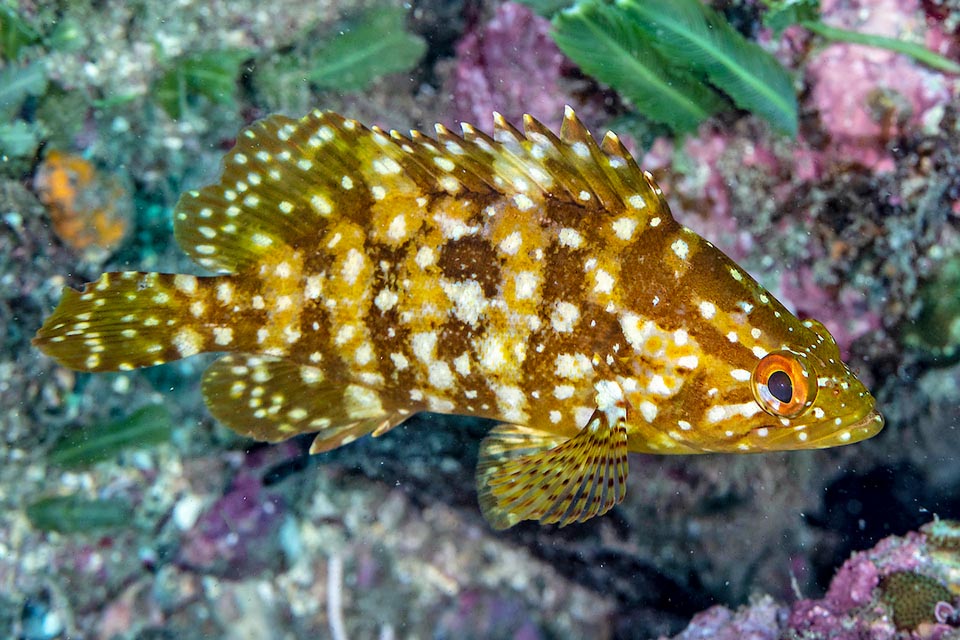
Here the bands remained but the livery is dominated by yellow. And the surprises of this tiny 18 cm grouper are not finished yet © Allison & Carlos Estape
Morphophysiology
Usually 18 cm long with a maximum of 30, Alphestes immaculatus is even smaller than the Caribbean Cephalopholis fulva that is even 25 cm long with a maximum of 44 cm, and, with the same size of Alphestes multiguttatus stands by sure among the smallest existing groupers.
The body structure is the classical one of the groupers, robust and compact with a huge mouth provided of protruding lower jaw and big fleshy lips.
The teeth are small, arranged on 3-5 rows per jaw, to which are added, over and below, on the front, two canines for grabbing the preys.
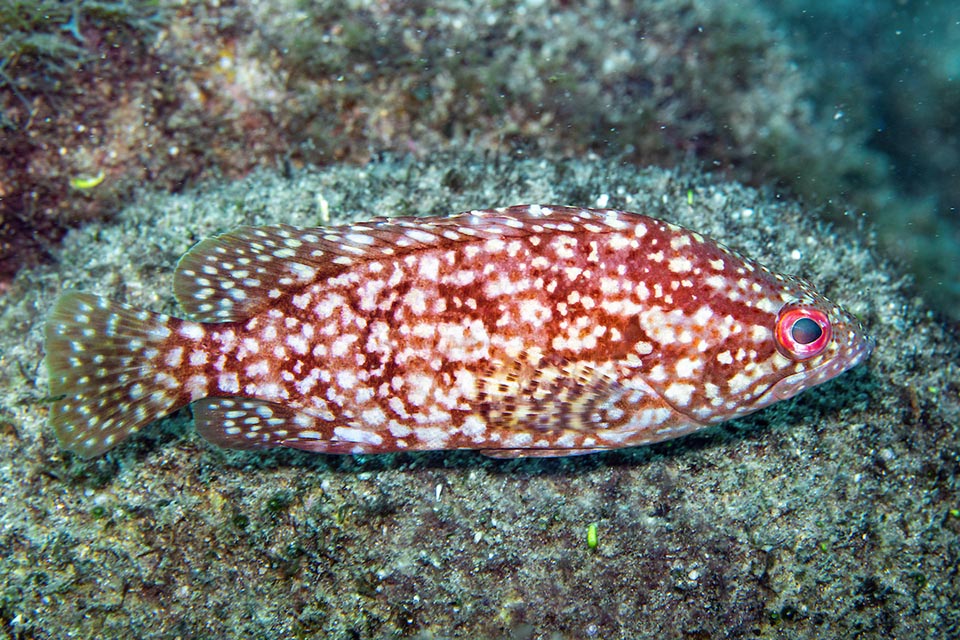
In fact it can almost totally cancel also the dark bands. So, not seen by predators, it hunts, at times motionless, in ambush, the tiny fishes and the passing-by crustaceans © Allison & Carlos Estape
The preoperculum, rounded, has the back edge serrated and has a great defensive spine, often covered by the skin.
The dorsal fin counts 11 spiny rays and 17-19 soft, the anal 3 spiny rays and 9 unarmed, the pelvic do not have spines and the pectoral ones , with 16-18 soft rays, have 7-8 characteristic irregular transversal bands of small dark spots.
The body and the head are mainly reddish brown, marbled with dark irregular vertical bands more or less emphasized by the chromatophores that change instantly the look of the fish depending on the mood and the mimetic necessities. The pale dotting of the fins is however always visible.
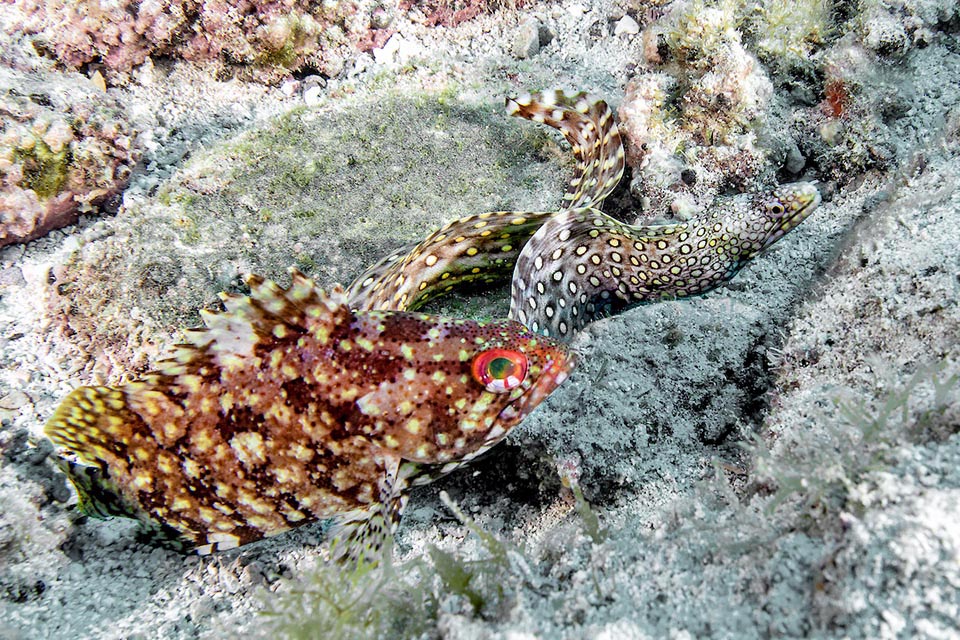
More active at night, often Alphestes immaculatus hunts together Muraena lentiginosa who drives out small fishes. A good bond but at times disturbed by Serranus psittacinus who steals them loot © Allison & Carlos Estape
The juveniles, easy to recognize in the photos due to the eyes proportionally bigger than those of the adults, have a simplified livery similar to that of the parents and put immediately the extraordinary mimetic qualities of the species to good use.
Ethology-Reproductive Biology
Alphestes immaculatus feeds on crustaceans and small fishes that, thanks to its mimicry, often captures immobile, in ambush, close to the den. But it’s more active during the night, when it goes out alone hunting, in couples or in small schools of up to 6 conspecifics.
Sometimes, he’s also a team player with local morays such as Muraena lentiginosa. At the sight of these Anguilliformes the small hidden fishes flee in terror, knowing that the moray may reach them into their recesses, and the grouper takes advantage of this catching them with quick flashes.
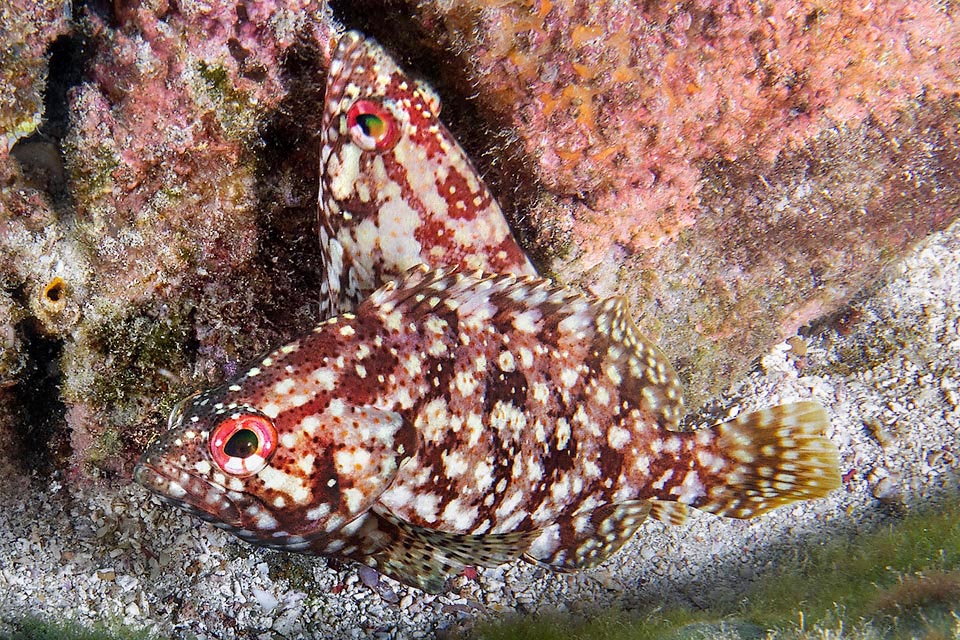
A couple. Little is known about this species’ reproduction that reaches sexual maturity when 12-13 cm long. However eggs and larvae are pelagic © Allison & Carlos Estape
However, it has been noted that sometimes a small killjoy, Serranus psittacinus, joins these two, following them and trying to be the first to pounce on the preys or, worse, to snatch the food from their mouths. It is obvious that the harmony breaks: the two serranidae fight when they throw themselves together on the driven out fishes and the moray, disturbed, ends up attacking them both.
Conversely, a one meter long grouper like Mycteroperca rosacea is well accepted, because its size contributes in frightening the preys and attacks only the bigger fishes.
There is not much information concerning the reproduction of Alphestes immaculatus. Both males and females reach sexual maturity when about 12-13 cm long, but these are usually more numerous and bigger.
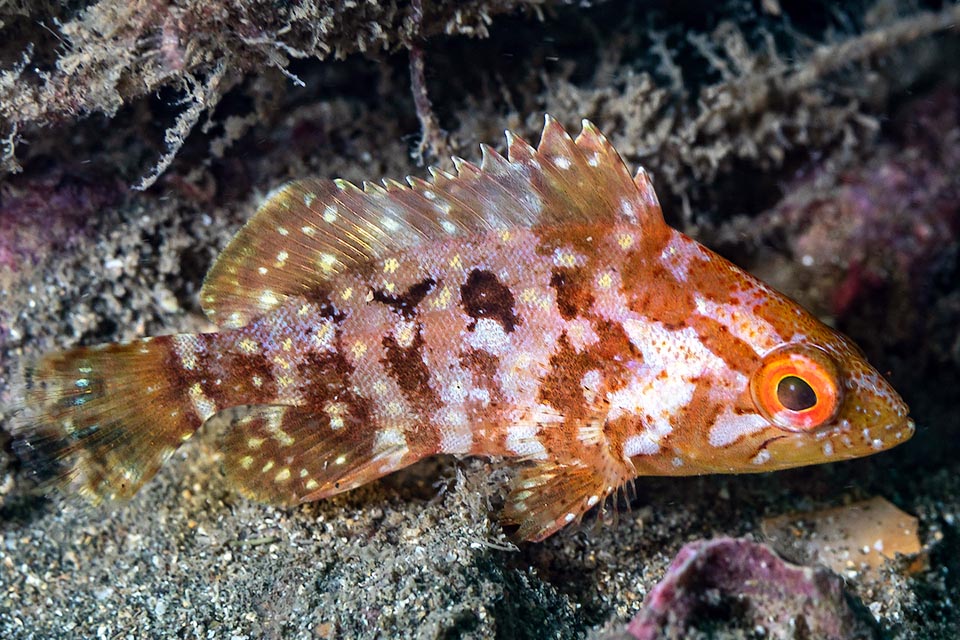
A juvenile. The livery, slightly simplified, is already similar to the adults’ one. Alphestes immaculatus reaches the age of 9 years and is not an endangered species © Allison & Carlos Estape
In the Gulf of California the reproductive period falls between April and October, and it seems that the fecundation does not happen in groups but in couples. Like all groupers, eggs and larvae are pelagic. They grow up fast and the life expectancy of the small fishes is about 9 years.
The resilience of Alphestes immaculatus is high, with a minimum time of less than 15 months for the doubling of the populations and the fishing vulnerability, low, marks only 20 on a scale of 100. As a consequence, it appears as “Least Concern“, that is at “Minimal Worry” in the IUCN Red List of the endangered species.
Synonyms
Alphestes galapagensis Fowler, 1944; Alphestes fasciatus Hildebrand, 1946.
→ For general information about FISH please click here.
→ For general information about BONY FISH please click here
→ For general information about CARTILAGINOUS FISH please click here.
→ To appreciate the BIODIVERSITY of BONY FISH please click here.
→ To appreciate the BIODIVERSITY of CARTILAGINOUS FISH please click here.
